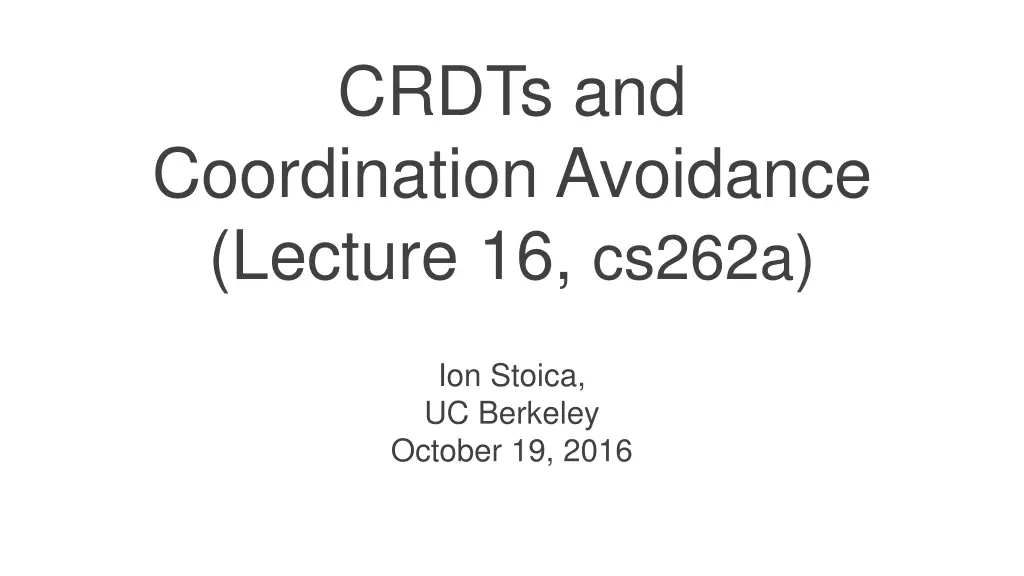
Understanding CRDTs and Data Replication Strategies
Explore the concepts of Conflict-free Replicated Data Types (CRDTs), coordination avoidance, replicated data, consistency issues, strong consistency, conflicts, and eventual consistency in distributed systems. Learn about the trade-offs between consistency, availability, and scalability in data replication strategies.
Download Presentation

Please find below an Image/Link to download the presentation.
The content on the website is provided AS IS for your information and personal use only. It may not be sold, licensed, or shared on other websites without obtaining consent from the author. If you encounter any issues during the download, it is possible that the publisher has removed the file from their server.
You are allowed to download the files provided on this website for personal or commercial use, subject to the condition that they are used lawfully. All files are the property of their respective owners.
The content on the website is provided AS IS for your information and personal use only. It may not be sold, licensed, or shared on other websites without obtaining consent from the author.
E N D
Presentation Transcript
CRDTs and Coordination Avoidance (Lecture 16, cs262a) Ion Stoica, UC Berkeley October 19, 2016
Todays Papers CRDTs: Consistency without concurrency control, Marc Shapiro, Nuno Preguica, Carlos Baquero, Marek Zawirski Research Report, RR-6956, INRIA, 2009 (https://hal.inria.fr/inria-00609399v1/document) Coordination Avoidance in Database Systems, Peter Bailis, Alan Fekete, Michael J. Franklin, Ali Ghodsi, Joseph M. Hellerstein, Ion Stoica, Proceedings of VLDB 14 (http://www.vldb.org/pvldb/vol8/p185-bailis.pdf)
Replicated Data Replicate data at many nodes Performance: local reads Fault-tolerance: no data loss unless all replicas fail or become unreachable Availability: data still available unless all replicas fail or become unreachable Scalability: load balance across nodes for reads Updates Push to all replicas Consistency: expensive!
Conflicts Updating replicas may lead to different results inconsistent data s1 3 7 5 s2 3 7 5 s3 5 7 3
Strong Consistency All replicas execute updates in same total order Deterministic updates: same update on same objects same result s1 3 7 5 3 s2 3 7 5 s3 7 5 7 3 coordinate
Strong Consistency All replicas execute updates in same total order Deterministic updates: same update on same objects same result Requires coordination and consensus to decide on total order of operations N-way agreement, basically serialize updates very expensive!
Eventual Consistency If no new updates are made to an object all replicas will eventually converge to the same value Update local and propagate No consensus in the background scale well for both reads and writes Expose intermediate state Assume, eventual, reliable delivery On conflict Arbitrate & Rollback
Eventual Consistency If no new updates are made to an object all replicas will eventually converge to the same value Move consensus to background However: High complexity Unclear semantics if application reads data and then we have a rollback!
Strong Eventual Consistency Like eventual consistency but with deterministic outcomes of concurrent updates No need for background consensus No need to rollback Available, fault-tolerant, scalable But not general; works only for a subset of updates
State-based Replication Replicated object: a tuple (S, s0, q, u, m). Replica at process pi has state si S s0: initial state Each replica can execute one of following commands q: query object s state u: update object s state m: merge state from a remote replica
State-based Replication Algorithm Periodically, replica at pi sends its current state to pj Replica pj merges received state into its local state by executing m After receiving all updates (irrespective of order), each replica will have same state
Semi-lattice Partial order set S with a least upper bound (LUB), denoted m = x y is a LUB of { x, y} under iff m , x m y m x m y m m m It follows that is: commutative: x y = y x idempotent: x x = x associative: ( x y) z = x ( y z)
Example Partial order on set of integers : max( ) Then, we have: commutative: max(x, y) = max(y, x) idempotent: max(x, x) = x associative: max(max(x, y), z) = max(x, max(y, z))
Example Partial order on sets : U (set union) Then, we have: commutative: A U B = B U A idempotent: A U A = A associative: (A U B) U C = A U (B U C)
Monotonic Semi-lattice Object A state-based object with partial order , noted (S, , s0, q, u, m), that has following properties, is called a monotonic semi-lattice: 1. Set S of values forms a semi-lattice ordered by 2. Merging state s with remote state s computes the LUB of the two states, i.e., s m (s ) = s s 3. State is monotonically non-decreasing across updates, i.e., s s u
Convergent Replicated Data Type (CvRDT) Theorem: Assuming eventual delivery and termination, any state- based object that satisfies the monotonic semi-lattice property is SEC
Why does it work? Don t care about order: Merge is both commutative and associative Don t care about delivering more than once Merge is idempotent
Numerical Example: Union Set u: add new element to local replica q: return entire set merge: union between remote set and local replica {5 } {5} U {3} = {3, 5} {3, 5} U {5, 7} = {3, 5, 7} {5} {5 } {5} U {3, 5} = {3, 5} {5} {3, 5} U {5, 7} = {3, 5, 7} {5 } {5} {5} U {7} = {5, 7} {5, 7} U {3, 5} = {3, 5, 7}
Operation-based Replication An op-based object is a tuple (S, s0, q, t, u, P ), where S, s0 and q have same meaning: state domain, initial state and query method No merge method; instead an update is split into a pair (t, u ), where t: side-effect-free prepare-update method (at local copy) u: effect-free update method (at all copies) P: delivery precondition (see next)
Operation-based Replication Algorithm Updates are delivered to all replicas Use causally-ordered broadcast communication protocol, i.e., deliver every message to every node exactly once, consistent with happen-before order Happen-before: updates from same replica are delivered in the order they happened to all recipients (effectively delivery precondition, P) Note: concurrent updates can be delivered in any order
Commutativity Property Updates (t, u) and (t , u ) commute, iff for any reachable replica state s where both u and u are enabled u (resp. u ) remains enabled in state s u (resp. s u ) s u u s u u Commutativity holds for concurrent updates
Commutative Replicated Data Type (CmRDT) Assuming causal delivery of updates and method termination, any op-based object that satisfies the commutativity property for all concurrent updates is SEC
Numerical Example: Union Set t: add a set to local replica u: add delta to every remote replica {5 } {5} U {3} = {3, 5} {3, 5} U {7} = {3, 5, 7} {5} {5 } {5} U {3} = {3, 5} {5} {3, 5} U {7} = {3, 5, 7} {5 } {5} {5} U {5, 7} = {5, 7} {5, 7} U {3} = {3, 5, 7}
State-based vs Operation-based Replication Both are equivalent! You can use one to emulate the other Operation-base More efficient since you can ship only small updates State-based Just requires reliable broadcast; causally-ordered broadcast much more complex!
CRDT Examples (contd) Integer vector (virtual clock): u: increment value at corresponding index by one m: maximum across all values, e.g., m([1, 2, 4], [3, 1, 2]) = [3, 2, 4] Counter: use an integer vector, with query operation q: returns sum of all vector values (1-norm), e.g., q([1, 2, 4]) = 7 Counter that decrements as well: Use two integer vectors: I updated when incrementing D updated when decrementing q: returns difference between 1-norms of I and D
CRDT Examples (contd) Add only set object u: add new element to set m: union between two sets q: return local set Add and remove set object Two add only sets A: when adding an element, add it to A R: when removing an element, add it to R q: returns A\R
CAP Theorem You cannot achieve simultaneously Strong consistency Availability Partition tolerance Why?
SEC a Solution for CAP? Availability: a replica is always available for both reads and writes Partition tolerance: any communicating subset of replicas of eventually converges even if partitioned from the rest of the network. SEC is weaker than Fault tolerance: n-1 nodes can fail! Almost a solution: SEC weaker than Strong Consistency, though good enough for many practical situations
Summary Serialization, strong consistency Easy to use by applications, but don t scale well due to conflicts Two solutions to dramatically improve performance: CRDTs: eliminate coordination by restricting types of supported objects for concurrent updates Coordination avoidance: rely on application hints to avoid coordination for transactions Question: what do these model mean for applications?


